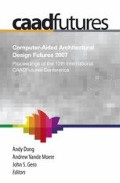In this research funded by NSFC (50408038), an agentbased simulation model is developed for the human evacuation behaviour determined by a list of so-called architectural clues in the environment. A research method is introduced with an application for one of these clue types called Doorway. A six-variable model and a related set of virtual scenes were constructed and implemented in a Head-CAVE system, in which 102 subjects were tested as in an evacuation game. With the binary logit regression analysis a utility function is estimated indicating how these variables affect human choice on any pair of doorways in a scene. Evidence was found that the distance from the decision point to the doorway is not always the most important factor as it is assumed in the other evacuation models.
Access this chapter
Tax calculation will be finalised at checkout
Purchases are for personal use only
Preview
Unable to display preview. Download preview PDF.
References
Achten, HH, Jessurun, AJ and de Vries, B: 2004, The Desk-Cave - A Low-Cost Versatile Virtual Reality Design and Research Setup Between Desktop and CAVE, in: B Ruediger, B Tournay and H Orbaek (eds), Proceedings of the 22nd International Conference on Education and Research in Computer Aided Architectural Design in Europe, Royal Danish Academy of Fine Arts, Copenhagen, pp. 142-147.
Arthur, P and Passini, R: 1992, WAYFINDING People, Signs, and Architecture, McGraw-Hill Book Company, New York.
Helbing, D, Farkas, IJ and Vicsek, T: 2000, Simulating dynamical features of escape panic, Nature 407: 487-490.
Kuligowski, ED and Peacock, RD: 2005, Review of Building Evacuation Models, NIST TN 1471, NIST Technical Note 1471.
Lawson, B: 2001, Language of space, Architectural Press, Oxford.
Nishinari, K, Kirchner A, Namazi, A and Schadschneider, A: 2004, Extended floor field CA model for evacuation dynamics, IEICE Transactions on Information and Systems E87-D (4): 726-732.
Sun, CY and de Vries, B: 2006, An Architecture-Based Model for Underground Space Evacuation, in: W Borutzky, A Orsoni, R Zobel (eds), Proceedings of the 20-th European Conference on Modelling and Simulation ECMS 2006, Bonn, pp. 578-583.
Sun, CY, de Vries, B and Dijkstra, J: 2007, A Research method on human behaviour induced by architectural clues in public underground spaces in Proceedings of CAADRIA 2007, Nanjin. (forthcoming)
Turner, A and Penn, A: 2002, Encoding natural movement as an agent-based system: an investigation into human pedestrian behaviour in the built environment, Environment and Planning B: Planning and Design 29: 473-490.
Author information
Authors and Affiliations
Editor information
Editors and Affiliations
Rights and permissions
Copyright information
© 2007 Springer
About this paper
Cite this paper
Sun, C., De Vries, B., Dijkstra, J. (2007). Measuring Human Behaviour Using Head-Cave. In: Dong, A., Moere, A.V., Gero, J.S. (eds) Computer-Aided Architectural Design Futures (CAADFutures) 2007. Springer, Dordrecht. https://doi.org/10.1007/978-1-4020-6528-6_37
Download citation
DOI: https://doi.org/10.1007/978-1-4020-6528-6_37
Publisher Name: Springer, Dordrecht
Print ISBN: 978-1-4020-6527-9
Online ISBN: 978-1-4020-6528-6
eBook Packages: Architecture and DesignEngineering (R0)

